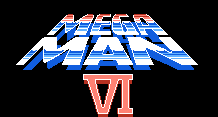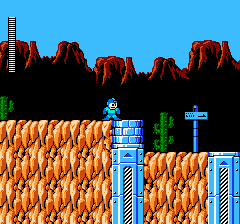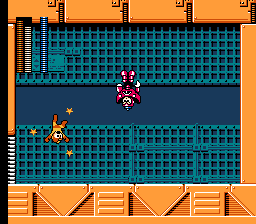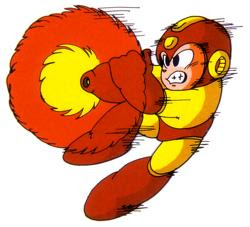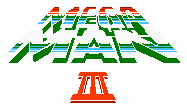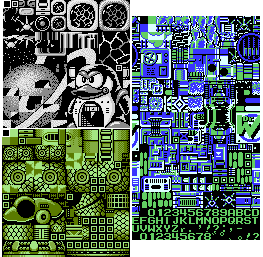One of the best conclusions for the NES series!
 Mega Man 5 met with some pretty heavy criticism, often being deemed outdated and unoriginal. Still, most of the fan base was still loyal and Capcom sought out to create the next in the franchise, Mega Man 6, for the Nintendo Entertainment System. Capcom released the Japanese version only, since the NES was being totally phased out, but Nintendo still published and released it in America. Alas, it would be the last Mega Man game created for the NES, and the last 8-bit Mega Man until the release of Mega Man 9. Mega Man 6 brings some new things to the table while keeping the core gameplay the series has always had intact.
Mega Man 5 met with some pretty heavy criticism, often being deemed outdated and unoriginal. Still, most of the fan base was still loyal and Capcom sought out to create the next in the franchise, Mega Man 6, for the Nintendo Entertainment System. Capcom released the Japanese version only, since the NES was being totally phased out, but Nintendo still published and released it in America. Alas, it would be the last Mega Man game created for the NES, and the last 8-bit Mega Man until the release of Mega Man 9. Mega Man 6 brings some new things to the table while keeping the core gameplay the series has always had intact.THE STORY: Like the plot of every other Mega Man, the story is pretty simple. Short and sweet. A scientist (with a very familiar look to him) by the name of "Mr. X" has organized the world's first Robot Master Tournament, a contest to see who's robots are superior fighters. Dr. Light doesn't enter his robots into the tournament, because he doesn't believe in fighting. However, he sends Mega Man to watch over the tournament. Once the eight finalist robot masters are announced, it is revealed also that Mr. X has re-programmed the eight robot masters to do his evil bidding, and wishes to take control of the world. Mega Man must once again set out and destroy eight evil robot masters and an evil doctor. I wonder who "Mr. X" was trying to fool with those shades.
THE GAMEPLAY: Exactly as the first 5 games, you have a stage select screen when you start up the game, each robot master's mugshot being the indicator for each. The game plays exactly as previous titles did. It's a side scrolling shoot-em-up. Fun fact by the way: each robot master was developed by a fan of the series!
You get to choose any order you want to complete the stages in. At the end of each stage, you'll go head to head with one of the robot masters that were re-programmed by Mr. X. Each robot master possess it's own unique special abilities, which Mega Man will obtain upon defeating that boss. Just like the previous games, each robot master is weak to another robot master's weapon. You'll have to guess who's weak to what, and some weaknesses will be obvious, and others obscure. Some stages now have alternate pathways, which will earn you one of four letters, which spell out "Beat". Getting all four letters will unlock Beat as a weapon to use, who will fly in and attack enemies who are in your way.
Rush is also back for this game, but he works quite differently this time around. Instead of summoning him and hopping on his back in some way, he now fuses with Mega Man. The Rush Jet adapter gives mega man a jumping boost, negating the need for Rush Coil. The other is the Rush Power Adapter, which will allow Mega Man to punch through certain large blocks. There's no need for a long-lasting jet in this game so one wasn't made. You'll also be able to pick up energy tanks and the like, just as in previous Mega Man games.
Another new feature that you can find is the energy equalizer, which causes the energy of the most-drained weapon to be increased when Mega Man picks up a weapon energy capsule, unless he's already has a different weapon selected and in use when picking up the energy. After finished all eight stages, you'll have to get through Mr. X's fortress, which is a series of stages that can't be chosen in any order you see fit. Also, there are no passwords to start you up at stages after the first Mr. X stage. It's a marathon of endurance, just like the previous Mega Man titles and their corresponding final stages.
THE SOUND: Mega Man 6's soundtrack is much in the same vein as Mega Man 4's. It tried to capture the essence and atmosphere of the game as opposed to trying to be catchy, like Mega Man, Mega Man 2, Mega Man 3, and Mega Man 5. Mega Man 6 did a fantastic job of what it was supposed to do. Much like in Mega Man 5, Beat still makes his little chirp when he comes in and attacks. Rush unfortunately wouldn't get his animal call thrown in until Mega Man 7. Still, the soundtrack here is great and so are the little sound effects. The series' soundtracks won't always be catchy, but they most certainly are always good.
Here is a remix too
 THE GRAPHICS: Even with the Super Nintendo Entertainment System's growing popularity and support, Capcom still released this game on the regular Nintendo Entertainment System. Some might think it was a bad thing, but once again Capcom has shown that they care more about the fun and awesome gameplay then the graphics.
THE GRAPHICS: Even with the Super Nintendo Entertainment System's growing popularity and support, Capcom still released this game on the regular Nintendo Entertainment System. Some might think it was a bad thing, but once again Capcom has shown that they care more about the fun and awesome gameplay then the graphics.The next addition to the classic series would show just how bad of an idea it is to focus too much on shiny new graphics. Mega Man belongs in 8-bit, and should stay in 8-bit. Too bad they forgot about this with Mega Man 7 and 8, but at least they eventually came around with Mega Man 9. Still, the graphics look the same as the previous Mega Man games, which have always been solid, and still are here.
 OVERALL: Mega Man 6 was a great addition to the series and showed us how they can make a fun game while keeping the gameplay structure the same, and just changing or adding little bits here and there without altering too much. Unfortunately, this game has yet to be released on the Wii's virtual console, so you'll have to go to a used game store and pick up an old cartridge if your NES still works. You could also get the Mega Man Anniversary Collection for the PS2 and Gamecube if you wanna play this. Either way, it's a great addition to the franchise so go ahead and snag this game already!
OVERALL: Mega Man 6 was a great addition to the series and showed us how they can make a fun game while keeping the gameplay structure the same, and just changing or adding little bits here and there without altering too much. Unfortunately, this game has yet to be released on the Wii's virtual console, so you'll have to go to a used game store and pick up an old cartridge if your NES still works. You could also get the Mega Man Anniversary Collection for the PS2 and Gamecube if you wanna play this. Either way, it's a great addition to the franchise so go ahead and snag this game already!NAME: MEGAMAN 6
SYSTEM: NES
